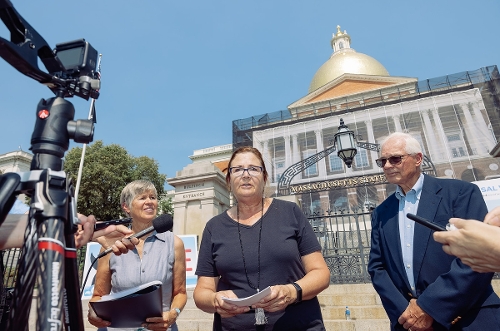President Biden set a goal of 30 gigawatts of offshore wind to reduce carbon dioxide emissions. The EPA created a calculator that shows the impact of such cuts would reduce global temperature by an insignificant 0.004 degrees Fahrenheit. The US Bureau of Ocean Energy Management (BOEM) and the NOAA Fisheries Service failed to use the best available science in its approval process.
Loud turbine installation activities and continued turbine operations threaten the critically endangered North Atlantic right whale. New studies found more frequent whale sightings and more operational noise interference from a switch to larger turbines by the developer. The threat of a lawsuit resulted in the NOAA Fisheries Service promise of a new study, but with no timeline for completion. The plaintiffs want the development stopped until the study is completed.
Turbine blades sweep an area the size of eight football fields with blade tips whirling at up to 180 mph, posing a hazard to birds in the Mid-Atlantic Flyway. Thousands of miles of high voltage cables will bring power ashore. Acres of concrete and rocks will be placed on the seabed to prevent scouring, changing the ocean habitat risking death to marine life at the bottom of the food chain. No studies have been done to estimate the potential loss of marine and avian life.
Thousands of Chrysler Building-sized turbines could occupy Vineyard Wind and six other adjoining leases covering an area the size of Rhode Island. Tourists may not return to beaches with visible turbines. A BOEM study with smaller turbines determined they would "dominate" the horizon at 15 miles, and a second study showed up to 38% of beach renters would not return if turbines were visible. BOEM ignored both studies. Instead, BOEM used a tourism impact study that one of its authors has stated is not applicable for the larger turbines planned for the Vineyard Wind project.
BOEM moved a lease area near Kitty Hawk National Park 28 miles from shore to protect the view. New York State created a 20-mile exclusion zone based on the BOEM study, canceled a lease area 12 miles off the Hamptons, and BOEM approved the cancelation. However, BOEM still supports turbines as close as 14 miles from Nantucket and between 10 and 15 miles in most of the 17 lease areas planned along the east coast.
Experiences in Europe and BOEM's own remarks suggest commercial fishermen will abandon prime fishing grounds covered with turbines. Concerns over potential damage to fishing gear increased vessel collisions, and the higher cost of insurance are the driving factors. The 900 feet tall turbines drove a Coast Guard determination that the Search and Rescue operations would be compromised, adding to safety concerns.
Turbines also eliminate the ability to do estimates on the population of commercial seafood species to establish "take" limits. BOEM decided finding a new population estimate procedure would take too long. Timing on a solution was left indeterminate, if ever.
The lack of answers to so many critical questions is a direct result of BOEM releasing a "Final Environmental Impact Statement" just nine days after accepting the developer's permit request. BOEM has provided a target-rich arena for litigation.
Besides the legal issues, Vineyard Wind will cost about 10 cents/kilowatt-hour over its expected 20-year life, according to the National Renewable Energy Laboratory, over three times as much as the current wholesale price of power. Even solar and onshore wind power is much less expensive at about $0.04.
Considering the higher cost of electricity, lost tourism, and fishing, the President's offshore wind plan might cost half a trillion dollars and 150,000 jobs. Over $250 billion may go to Europe to pay for turbines, vessels, installation crews, and subsidies paid by Americans.
David T. Stevenson is Director of the Center for Energy & Environment at the Caesar Rodney Institute and a founding member of the American Coalition for Ocean Protection
